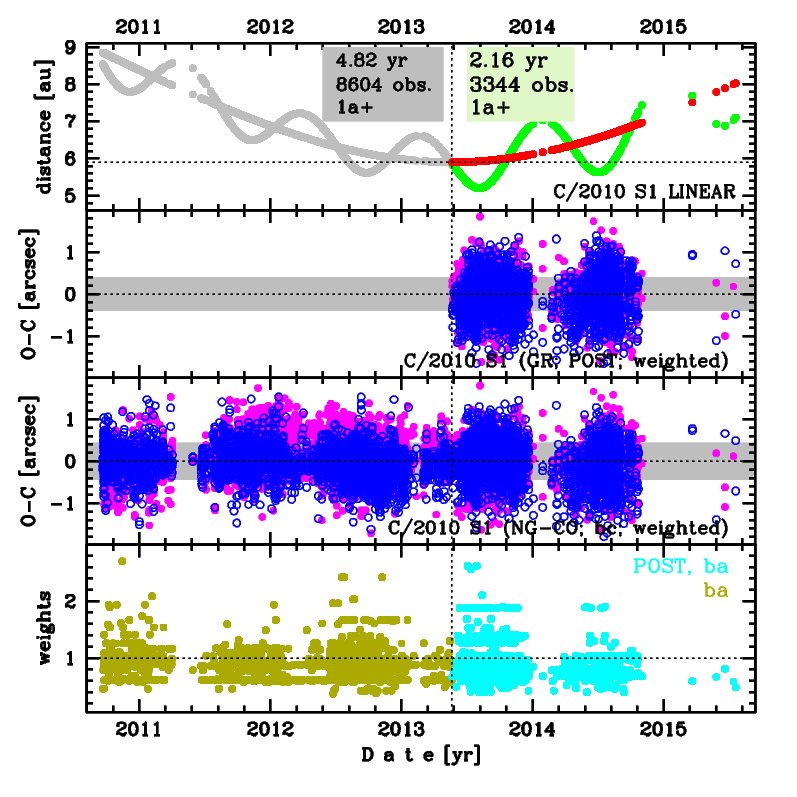C/2010 S1 LINEAR
more info
Comet C/2010 S1 was discovered on 21 September 2010 and next observed almost continuously by 4.8 yr in a range of heliocentric distances: 8.85 au – 5.900 au (perihelion) – 8.02 au. At the moment of discovery, it was two years and eight months before perihelion passage (see figure).
Comet had its closest approach to the Earth on 4 August 2013 (5.205 au, 2.5 months after perihelion).
NG orbit is possible to obtained using the full data arc; however uncertainties of NG parameters are notable, especially for A2 (see solutions ac and bc differing only in data weighting).
This Oort spike comet suffers a tiny planetary perturbations during its passage through the planetary system.
See also Królikowska and Dones 2023 and Królikowska and Dybczyński 2017.
Comet had its closest approach to the Earth on 4 August 2013 (5.205 au, 2.5 months after perihelion).
NG orbit is possible to obtained using the full data arc; however uncertainties of NG parameters are notable, especially for A2 (see solutions ac and bc differing only in data weighting).
This Oort spike comet suffers a tiny planetary perturbations during its passage through the planetary system.
See also Królikowska and Dones 2023 and Królikowska and Dybczyński 2017.
| solution description | ||
|---|---|---|
| number of observations | 3344 | |
| data interval | 2013 05 21 – 2015 07 19 | |
| data arc selection | data generally limited to post-perihelion (POS) | |
| range of heliocentric distances | 5.9 au – 5.90 au (perihelion) – 8.02 au | |
| detectability of NG effects in the comet's motion | comet with determinable NG~orbit | |
| type of model of motion | GR - gravitational orbit | |
| data weighting | YES | |
| number of residuals | 6556 | |
| RMS [arcseconds] | 0.41 | |
| orbit quality class | 1a+ | |
| orbital elements (heliocentric ecliptic J2000) | ||
|---|---|---|
| Epoch | 2013 05 28 | |
| perihelion date | 2013 05 20.28353889 | ± 0.00063335 |
| perihelion distance [au] | 5.89987675 | ± 0.00000191 |
| eccentricity | 1.00191546 | ± 0.00000254 |
| argument of perihelion [°] | 118.613226 | ± 0.000065 |
| ascending node [°] | 93.430432 | ± 0.000008 |
| inclination [°] | 125.335719 | ± 0.000006 |
| reciprocal semi-major axis [10-6 au-1] | -324.66 | ± 0.43 |

Upper panel: Time distribution of positional observations with corresponding heliocentric (red curve) and geocentric (green curve) distance at which they were taken. The horizontal dotted line shows the perihelion distance for a given comet whereas vertical dotted line — the moment of perihelion passage.
Middle panel(s): O-C diagram for a given solution (sometimes in comparison to another solution available in CODE), where residuals in right ascension are shown using magenta dots and in declination by blue open circles.
Lowest panel: Relative weights for a given data set(s).
Middle panel(s): O-C diagram for a given solution (sometimes in comparison to another solution available in CODE), where residuals in right ascension are shown using magenta dots and in declination by blue open circles.
Lowest panel: Relative weights for a given data set(s).